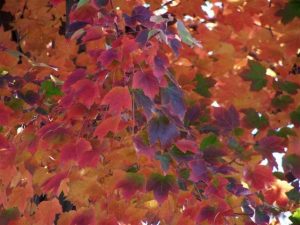Some years back, my now-deceased hubby and I were sitting in the swing on our deck enjoying a warm, fall afternoon. A breeze came through, fluttering a few leaves down to the deck and garden. “Ah,” I mused, “it’s like watching golden snowflakes fall.” His reply, “Yeah, but… (unfortunately)….they don’t melt!” Yes, indeed, what to do with all those leaves?
There are several options for the gardener to consider: 1. Leave the leaves where they fall. 2. Rake and compost them. 3. Rake, shred and use the shredded material as mulch.
4. Rake and burn them, or 5. Take them to the dump. For me, the only options are the first three. Because the leaves from my deciduous trees and shrubs are valuable assets to my garden, I don’t ever think of disposing of them.
At this time of year most of us head outside to ‘tidy up’ our gardens-raking leaves, pruning and clearing out any extra debris. But, let’s think about the leaves and debris as food for our gardens. If you simply leave the leaves where they fall in your planting beds to form natural mulch, you can provide your plants with a protective blanket in winter, conserve water year-round, and enrich your soil as the plant material decomposes.
If you are lucky to have an overabundance of leaves in your yard, composting is a sensible solution to disposing of them. Or, if you are fortunate to have a chipper/shredder, you can turn the leaves and prunings into wonderful mulch.
Don’t have a chipper/shredder? Another solution is to place the leaves in a 30 gallon garbage can and use a weed-eater as a giant mixer! In an article in the National Wildlife publication, Michael Goatley, Jr., an agricultural extension turf grass specialist based at Virginia Tech University, points to recent studies that show you can even leave fallen leaves on your lawn, as long as you pass over them once or twice with a rotary mower to chop them into small pieces.
According to the CalRecycle website – http://www.calrecycle.ca.gov/organics/, California buries an estimated 35 million tons of waste in landfills each year; 11.2 MILLION tons is compostable “green waste.” This material in landfills, when decomposing and lacking sufficient oxygen, creates methane gas. A powerful greenhouse gas, methane is 23 times more effective at trapping heat in the atmosphere than carbon dioxide. Not surprisingly, solid waste landfills are the single largest man-made source of methane in the United States. Something to think about while you’re on the way to the dump with those leaves!
If you absolutely cannot keep leaves and prunings in your own yard and garden, offer them to a neighbor who can use them for compost or mulch. That’s a win-win situation for you, area gardens and the environment!
This is a reprint of a seasonal article written by Carolee James a few years ago.




